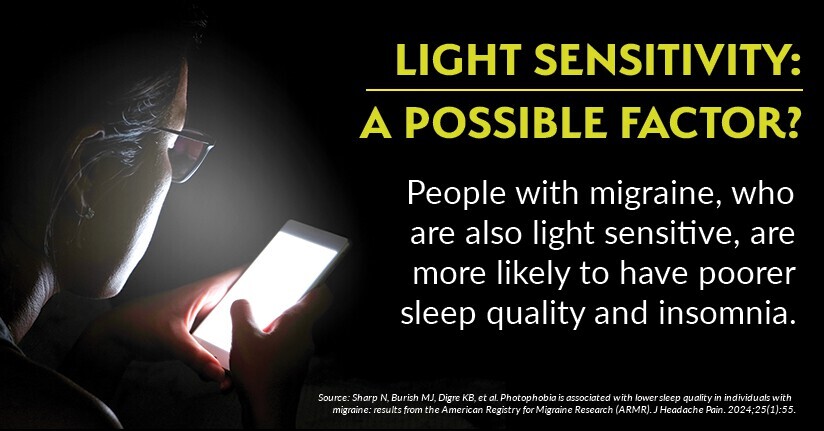Sleep and Migraine: A Complex Relationship
If you’ve ever felt like your sleep and your migraines are in constant battle with each other, you’re not imagining it. The connection between sleep and migraine is complex, dynamic, and deeply intertwined. People with migraine often experience disrupted sleep, and in turn, those sleep disturbances can trigger or worsen migraine attacks.
Understanding how sleep and migraine influence one another—as well as the role that light and light sensitivity play—can be a powerful step in managing symptoms and improving overall well-being.
How Migraine Disrupts Sleep (and Vice Versa)
People living with migraine are at a significantly higher risk for experiencing a wide range of sleep impairments. These issues include insomnia, trouble falling asleep, frequent nighttime awakenings (including headaches that wake them up), and non-restorative sleep. There is even evidence that connects migraine to a whole host of sleep disorders, such as sleep apnea and restless leg syndrome.1,2
The relationship goes both ways too.
Experts have suggested that there may be as much as FOUR TIMES greater risk for developing migraine if you experience impaired sleeping patterns. In addition, changes in your usual sleep schedule can be a major trigger for an attack, especially the next day. Sneaking in an extra hour of sleep, for instance, may lead to what some researchers have called a “weekend migraine”—a phenomenon where sleeping in on your day off or while on vacation can set off an attack.3 Inconsistent sleep patterns, whether from travel, late nights, or stress, can have a similar effect.
Sleep disruptions don’t affect everyone with migraine the same way, either. Women and individuals over the age of 35 may feel the weight of the combined effect of migraine and poor sleep. This can lead to a greater overall burden: more frequent and intense attacks, increased anxiety and depression, and a significant impact on quality of life.4
Sleep For Migraine Relief
While any change in sleep can be a trigger, proper rest can be a source of relief as well. Many people with migraine find that sleeping through a migraine attack—if they can—can actually reduce their symptoms.2 However, this effect may not be as relieving for everybody, especially if you are chronic, and it can be generally difficult to sleep through an attack. So it is not a one-size-fits-all approach.
Ultimately, this reinforces how central and interconnected the sleep-migraine relationship really is—and how important it is to optimize sleep patterns whenever possible.
Why Migraine And Sleep Are Interconnected
Beyond lifestyle triggers, there may be biological reasons why sleep and migraine are so deeply connected. Researchers have found that certain brain chemicals and regions play roles in both sleep regulation and migraine development.
For example, dopamine, a neurotransmitter involved in mood, sleep, and pain processing, may contribute to pre-attack symptoms in migraine.5 This could explain why many people report yawning, drowsiness, or fatigue in the hours leading up to an attack. These symptoms point to a shared physiological mechanism, rather than just a coincidence.
The Role of Light and Light Sensitivity
No conversation about migraine and sleep would be complete without mentioning light sensitivity—a symptom experienced by the vast majority of people with migraine. Known medically as photophobia, this sensitivity can result in worse sleep-related outcomes; and the more sensitive to light you are, the more negatively impacted your sleep may be.6

Beyond general light exposure, certain types of light—especially blue light from screens and devices—can significantly disrupt the body's natural sleep rhythm. Studies have shown that blue light in the evening can:7,8
- Suppress melatonin production (a hormone that regulates sleep)
- Make it harder to fall and stay asleep
- Lead to less deep, restorative sleep
- Increase feelings of fatigue and tiredness the next day
For people with migraine, who already have a heightened sensitivity to certain blue light, this kind of light exposure can make them more vulnerable. It can create an unpleasant loop whereby light impacts restful sleep and aggravates migraine symptoms, then further impaired sleep results from migraine progression, migraine heightens sensitivity to light and affects your sleep the next day, and so forth.
Even with all this knowledge about how light sensitivity compounds sleep and migraine, the answer cannot be to avoid light altogether.
In fact, those with migraine tend to seek out a dark room or minimize their light exposure in order to reduce the possibility of it triggering their attacks. But this lack of light could backfire and have negative consequences on your circadian rhythms, and research has even shown that seeking out light improves sleep quality in a variety of ways.6
Tips for Managing Sleep and Migraine
The good news is that there are practical steps you can take to break this cycle. Here are a few suggestions for improving sleep and better managing your migraine symptoms:
- Stay regular with your migraine medications. It is important to continue to take any acute or preventative migraine medications, per your doctor’s instructions, as they can help manage your symptoms and related effects.
- Maintain a regular sleep schedule. Try to go to bed and wake up at the same time every day—even on weekends.
- Limit screen time in the evening. Avoid bright devices for at least an hour before bed. If that’s not possible, consider using screen filters or other options for filtering sleep-disrupting blue light; but again, this only applies to the 1-2 hours before you plan to go to sleep.
- Create a sleep-friendly environment. Keep your bedroom cool, dark, and quiet. Blackout curtains and soft, warm lighting can help reduce stimulation.
- Address light sensitivity. As discussed, you don’t want to completely eliminate light, so find resources that can help you manage your exposure to the most irritating wavelengths. By filtering the most problematic light, TheraSpecs glasses may help people to live well with migraine, as part of an overall light management plan.
- Track patterns and triggers. Keep a migraine diary to note sleep changes and how they relate to your symptoms. Work with your doctor to identify possible improvements.
References:
1Tiseo C, Vacca A, Felbush A, et al. Migraine and sleep disorders: a systematic review. J Headache Pain. 2020;21(1):126. doi:10.1186/s10194-020-01192-5
2Vgontzas A, Pavlović JM. Sleep Disorders and Migraine: Review of Literature and Potential Pathophysiology Mechanisms. Headache. 2018;58(7):1030-1039. doi:10.1111/head.13358
3Waliszewska-Prosół M, Nowakowska-Kotas M, Chojdak-Łukasiewicz J, Budrewicz S. Migraine and Sleep-An Unexplained Association?. Int J Mol Sci. 2021;22(11):5539. doi:10.3390/ijms22115539
4Duan S, Ren Z, Xia H, Wang Z, Zheng T, Liu Z. Association between sleep quality, migraine and migraine burden. Front Neurol. 2022;13:955298. doi:10.3389/fneur.2022.955298
5Barbanti P, Fofi L, Aurilia C, Egeo G. Dopaminergic symptoms in migraine. Neurol Sci. 2013;34(1):67–70. doi:10.1007/s10072-013-1415-8
6Sharp N, Burish MJ, Digre KB, et al. Photophobia is associated with lower sleep quality in individuals with migraine: results from the American Registry for Migraine Research (ARMR). J Headache Pain. 2024;25(1):55. doi:10.1186/s10194-024-01756-9
7Ishizawa M, Uchiumi T, Takahata M, Yamaki M, Sato T. Effects of pre-bedtime blue-light exposure on ratio of deep sleep in healthy young men. Sleep Med. 2021;84:303-307. doi:10.1016/j.sleep.2021.05.046
8Nagata JM, Singh G, Yang JH, et al. Bedtime screen use behaviors and sleep outcomes: Findings from the Adolescent Brain Cognitive Development (ABCD) Study. Sleep Health. 2023;9(4):497-502. doi:10.1016/j.sleh.2023.02.005

TheraSpecs® Glasses for Light Sensitivity
Find the glasses that fit your needs and lifestyle, and stay protected from screens, fluorescents, unwanted blue light, sunlight, flashing lights, and more.
Shop Now



